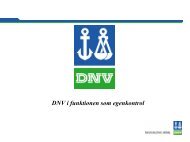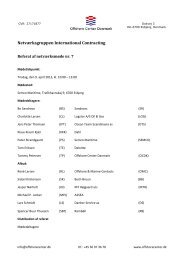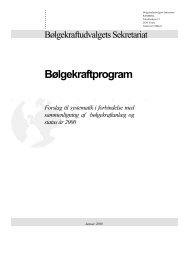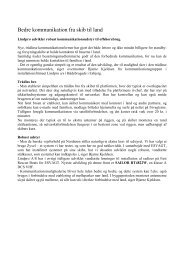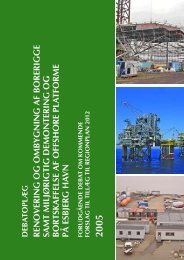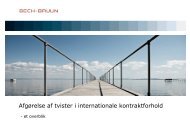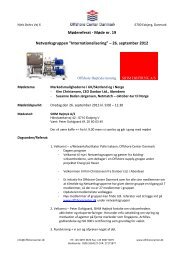Read News Magazine (pdf) - Offshore Center Danmark
Read News Magazine (pdf) - Offshore Center Danmark
Read News Magazine (pdf) - Offshore Center Danmark
Create successful ePaper yourself
Turn your PDF publications into a flip-book with our unique Google optimized e-Paper software.
The Extraction Degree<br />
could be increased to 50%<br />
Researchers and oil companies<br />
are working intensively on the<br />
development of methods to increase<br />
the extraction degree<br />
in the Danish part of the North<br />
Sea. Denmark’s leading oil<br />
researchers at the Technical<br />
Univercity of Denmark and at<br />
Aalborg University (Esbjerg Institute)<br />
expect that the degree<br />
can be increased to 50% – the<br />
double of the actual level.<br />
In the late 80’es the horizontal drilling method<br />
opened up new opportunities for the Danish<br />
oil and gas industry in the North<br />
Sea. Later water injection followed<br />
as an effective method to<br />
stimulate the extraction. CO2 injection<br />
could be the next big step<br />
in the endeavours to increase<br />
the vital extraction degree and<br />
prolong the Danish selfsuffi<br />
ciency.<br />
- People often quote me for saying that I<br />
expect that we can increase the extraction<br />
degree in the Danish part of the North Sea to<br />
50%. Even though it will be diffi cult to reach<br />
such goal, I think that we should consider it as<br />
our national strategy, Denmark’s leading oil<br />
researcher, professor Erling H. Stenby, Department<br />
of Chemical Institute for Engineering,<br />
the Technical University of Denmark (DTU),<br />
informs.<br />
The DTU professor takes us on a journey<br />
to the more than 50 years old Weyburn oil<br />
fi eld, which had reached a worn-down level,<br />
when the oil company EnCana decided to<br />
inject CO2 in order to stretch out the production.<br />
Via a 300 km long pipeline taken from a<br />
coal gasifi cation plant in North Dakota the CO2<br />
residual gas from the natural gas production<br />
was led to the oil fi eld in the middle of<br />
the North American continent, and with a<br />
very promising result: During the following<br />
years, the production increased by 25%.<br />
- Weyburn is of course a land-based fi eld,<br />
however, the geological conditions are not very<br />
different from the Danish section, and provided<br />
10 <strong>Offshore</strong> <strong>Center</strong> <strong>Danmark</strong><br />
Yearbook 2008<br />
that the CO2 will react as it did in Canada, we<br />
will look at a very promising production for<br />
many years to come, Erling H. Stenby states.<br />
Hesitation in Denmark<br />
and Norway<br />
Supported by the Danish National Advanced<br />
Technology Foundation a series of companies<br />
headed by DONG Energy are conducting a<br />
research project, with the purpose of creating<br />
a basis for a decision regarding a test plant<br />
with CO2 injection. The heavy fi nancial<br />
decision whether CO2 can be introduced in<br />
the Danish oil extraction process cannot be<br />
taken, before the project has been completed.<br />
Marginal Fields<br />
Reservoirs with a limited occurrence of oil and gas.<br />
This could also be larger deposits with an expected low<br />
extraction degree due to the geological conditions.<br />
Finally, larger occurrences with diffi cult production conditions<br />
due to large water debts or poor infrastructure,<br />
which complicates the transportation of the oil/gas.<br />
- Very large quantities of CO2 would have<br />
to be used, and it would furthermore be necessary<br />
to use a pipeline from shore. CO2 has<br />
been successfully used for decades, mainly in<br />
the US, Canada and Hungary, but its employment<br />
is limited mainly by the occurrence of<br />
CO2 . In the US as well as in Hungary the CO2<br />
occurrence is geological, whereas in Canada<br />
it will have to be supplied, which would also<br />
be the case in the North Sea. Neither Denmark<br />
nor Norway use CO2 as yet, Erling H. Stenby<br />
informs.<br />
The Chalk is not the main Reason<br />
The low permeable chalk is often mentioned<br />
as the main reason that the Danish part of the<br />
North Sea is an area where it is diffi cult to<br />
extract oil and gas. This is not the whole truth.<br />
Norway’s largest oil fi eld, Ekofi sk, is also a low<br />
permeable chalk fi eld, and besides, the oil companies<br />
in the Norwegian and the British sector<br />
face diffi culties in sandstone fi elds as well.<br />
- Our job is to develop better technologies to<br />
extract the oil, Enhanced Oil Recovery (EOR),<br />
taking parameters as rock, oil viscosity, pres-<br />
MARGINAL<br />
FIELDS<br />
sure and temperature into consideration, Erling<br />
H. Stenby informs.<br />
The accessibility of a reservoir does not<br />
entirely depend on the thickness of the chalk<br />
layers. E.g., the chalk layer in the DUC’s<br />
Valdemar fi eld is not very thick, but as it covers<br />
a large area, the oil extraction is complicated.<br />
In such reservoir horizontal drillings and<br />
unmanned STAR platforms are indeed an<br />
advantage.<br />
The extraction conditions in the North<br />
Sea differ substantially. The latest prognosis<br />
carried out by the Danish Energy Authority<br />
stating an extraction degree of 24% comprises<br />
big variations, from fi elds with an extraction<br />
degree below 5% to fi elds where<br />
it is possible to extract 35-40%,<br />
e.g. in the DUC’s Skjold fi eld.<br />
Additional advanced<br />
Methods<br />
At the EOR area several methods<br />
are being tested to improve the<br />
oil and gas extraction. One of the<br />
methods is to introduce energy by increasing<br />
the temperature. The procedure is to inject<br />
steam into the oil layers, a method which,<br />
however, cannot be employed on large debts,<br />
as well as in situ combustion - a combustion<br />
process inside the reservoir, where oxygen is<br />
introduced from the surface, in order to form<br />
nitrogen. Nitrogen does not mix with the oil as<br />
is the case with CO2 , but it heats the CO2 and<br />
thereby lowers the viscosity, which allows a<br />
free oil fl ow. In Romania the method has been<br />
used for a number of years, and even though<br />
we for the time being are not conducting any<br />
tests, we have not abandoned the method.<br />
Microbial methods, e.g. to inject active ingredients,<br />
such as detergents, into the oil reservoir<br />
to loosen the oil from the pores, have proved<br />
to be an expensive method to increase the<br />
extraction degree. It would be more cost effective<br />
to introduce microorganisms, which can<br />
reproduce and increase the activity in the reservoir.<br />
Aalborg University (Esbjerg Institute) is<br />
currently researching the consequences such a<br />
method would have on a 5-10 years’ basis. ■



